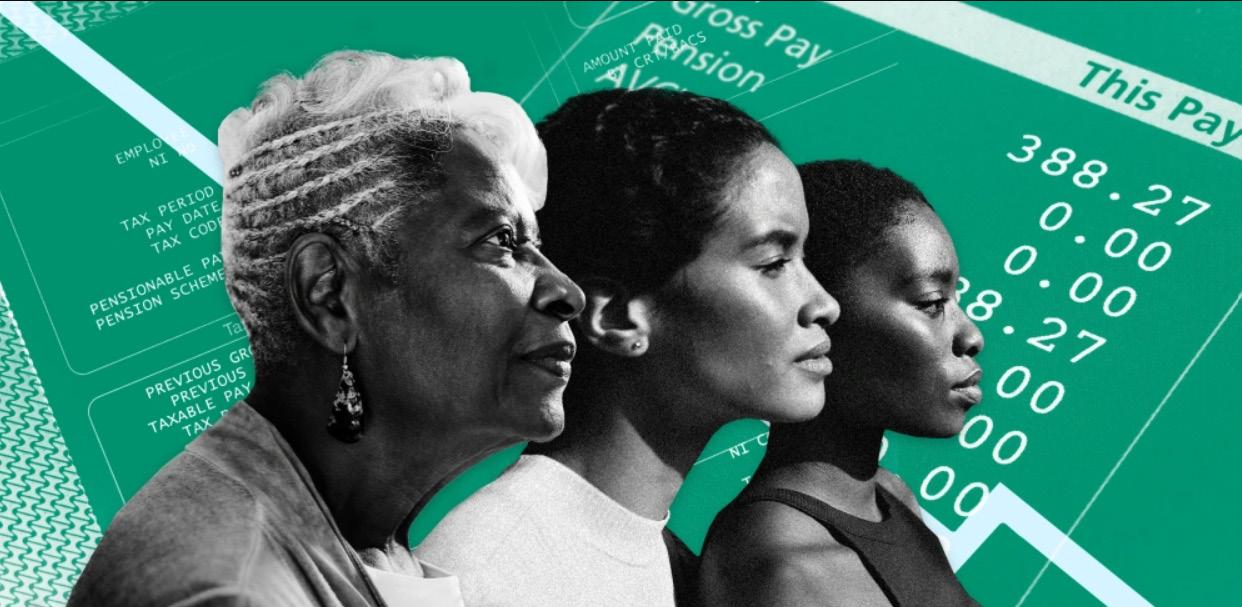

POLICY BRIEF
Ja’Lia Taylor, Ph.D. NCNW Director of Policy, Telecommunications and Technology
EXECUTIVE SUMMARY
Although Black women are among the most educated demographics in the United States, earning college and advanced degrees at record rates, they continue to face the steepest wage gaps in the American labor market. Compared to white men, who as a group have lower educational attainment, Black women earn only 64 cents for every dollar (Institute for Women’s Policy ResearchNational Partnership for Women & Families). This pay disparity is not just a matter of personal economics. It is a public crisis that deepens poverty in the Black community, limits wealth accumulation, and sustains historical systems of racial and gender-based inequality.
Over the course of a 40-year career, the wage gap robs Black women of nearly $1 million in potential income. For most Black families, $1 million could be the difference between financial stability and economic precarity(Center for American Progress). It could fund homeownership, education, retirement, and access to healthcare. As over 60 percent of Black mothers are the primary or sole breadwinners for their families, this inequity has generational consequences that reverberate far beyond individual households.
This policy brief examines the historical context of Black women’s labor in the United States, the current pay gap crisis, the legislative landscape, new economic threats, and the critical need for intersectional policy solutions. It highlights H. Con. Res. 118, introduced in 2024 by Congresswoman Alma Adams, which formally recognizes the pay gap and its economic consequences and calls on Congress to reaffirm its commitment to equal pay for equal work.
BACKGROUND
A Legacy of Labor Without Compensation
The American economy has been built, shaped, and sustained by the labor, intellect, and resilience of Black women. From the earliest days of this nation, their contributions have been both foundational and transformative. Some forced from West Africa and trafficked across the Atlantic, many Black women brought with them deep expertise in agriculture, healing, and domestic management. One of the clearest examples of this knowledge is in rice cultivation. West African women, with centuries of expertise in rice farming, were intentionally brought to the Lowcountry regions of the United States because of their skills (Younger, 2025) . Their labor and agricultural techniques led to the creation of the Carolina Gold rice industry, which became a multi-billion dollar economic driver in the colonial South. The vital role that enslaved Africans played in shaping American agriculture has long been overlooked or minimized (Browne, 2024)
Despite their central role in building the nation’s wealth, Black women were never compensated for their labor. During slavery, they worked as field laborers, midwives, healers, and domestic workers without pay or recognition. After emancipation, many continued to perform essential roles in caregiving, domestic work, and nursing, yet remained excluded from early labor laws such as the Fair Labor Standards Act and Social Security protections. These exclusions were not accidental. They were the result of deliberate policy decisions that undervalued care work and institutionalized racial discrimination. Even during wartime, when Black women served as nurses, codebreakers, and factory workers, their service was often overlooked and unrewarded.
This legacy of economic exclusion is not confined to history. It reverberates through today’s workforce, shaping the lives of Black women who continue to be underpaid and undervalued.

Black Women’s Equal Pay Day and Current Statistics
The ongoing wage gap is one of the clearest indicators of continued economic injustice faced by Black women. In response to this persistent inequity, advocates and organizations launched public education campaigns to raise awareness. In 1996, the National Committee on Pay Equity established Equal Pay Day to symbolize how far into the year women must work to earn what men earned in the previous year (Blackhurst & Harris, 2022). As more data revealed even greater disparities across race and gender lines, the movement expanded. Black Women’s Equal Pay Day emerged as a distinct day of observance to spotlight how deeply the wage gap affects Black women specifically. In 2025, this day will fall on July 10, which means Black women must work nearly seven additional months into the year to earn what white, non-Hispanic men earned in the previous calendar year.

This stark inequity persists despite federal efforts to address pay discrimination. The Equal Pay Act of 1963 was a landmark law designed to eliminate wage disparities based on sex (Evans, 2019). It requires that men and women receive equal pay for equal work within the same establishment. While the law was an important early step in the fight for gender equality, it did not address wage disparities caused by race. It also failed to account for how race and gender can combine to create unique and compounding forms of discrimination. As a result, Black women remain particularly vulnerable to pay inequities that fall outside the scope of the law’s original protections.
Today, Black women working full-time year-round are paid just 64 cents for every dollar earned by white, nonHispanic men. When part-time and seasonal workers are included, the figure drops even further. Over the course of a 40-year career, this pay gap translates into nearly $1 million in lost income per Black woman. These lost earnings represent missed opportunities for homeownership, higher education, retirement savings, and overall long-term financial security.
Importantly, education does not close the gap. Black women with bachelor’s and master’s degrees often face wider wage disparities than those with only a high school diploma. This reinforces that the issue is not about individual qualifications or work ethic. Instead, it points to structural and systemic bias embedded in hiring practices, promotional pathways, and compensation decisions. Black women are overrepresented in low-wage occupations and underrepresented in leadership roles and high-paying sectors such as technology and finance, which further compounds the economic divide.
This wage gap is not just a statistic. It is the modern reflection of a longstanding pattern of exploitation, exclusion, and economic injustice. It restricts Black women’s ability to build wealth, provide for their families, and participate fully in the nation’s economy. Recognizing this history and addressing its present-day consequences is essential to designing policy solutions that are meaningful, equitable, and long overdue.
Why This Issue Matters: The Cost of Inequity
The wage gap is not just about take-home pay. It is about access to wealth, homeownership, savings, and the ability to pass assets from one generation to the next. With nearly $1 million in lost income per Black woman over a 40-year career, the Black community collectively loses billions of dollars in generational wealth. This deepens existing economic divides and continues a legacy of exclusion from economic opportunity.
Unequal pay has an immediate and tangible impact on families. Research by the Center for American Progress (2023) shows that 69 percent of Black mothers serve as the primary or sole breadwinners in their households. When Black women are underpaid, it directly reduces the resources available for essential needs such as
Why This Issue Matters: The Cost of Inequity (continued)
childcare, education, healthcare, and stable housing. These financial limitations extend beyond individual households, creating ripple effects that reinforce long-term disparities in health, opportunity, and overall quality of life across entire communities.
In addition to the wage gap itself, Black women face compounded barriers at the intersection of racism and sexism. They are often excluded from salary transparency, leadership positions, promotions, and fair negotiation processes. While they are overrepresented in low-wage jobs, they remain significantly underrepresented in executive roles and high-growth fields such as science, technology, engineering, and mathematics.
Workplace conditions also reinforce these inequities. Many employers enforce pay secrecy policies that prevent employees from discussing wages, making it difficult to identify and challenge discriminatory pay practices. Sexual harassment continues to disproportionately affect Black women, often resulting in career disruption or job loss. Additionally, the lack of family-friendly workplace policies such as paid leave and flexible schedules forces many women to make difficult choices between caregiving and career advancement. These systemic barriers compound the wage gap and must be addressed through comprehensive, equity-centered reforms.
New & Emerging Challenges: Amplifying the Economic Toll
Federal Workforce Firings Hit Black Women Hardest
In 2025, mass layoffs of probationary federal employees, prompted by Executive Order 14151 and a broader rollback of diversity, equity, and inclusion (DEI) initiatives, disproportionately affected Black women. As key contributors to the federal workforce, Black women experienced a sharp and targeted decline in job stability and economic security (Fast Company, 2025). The layoffs not only stripped away reliable, middle-class jobs but also dismantled a crucial pipeline of economic opportunity for many Black households. The impact was especially alarming in agencies where Black women made up a significant portion of the workforce. Key data points include:
A 33% drop in federal employment among Black women.
Layoffs of up to 46% at the Department of Education, where Black women were a major demographic group.
The loss of stable, middle-income jobs with benefits that has further destabilized families and weakened local economies.
Rising Unemployment
This wave of layoffs contributed to a troubling rise in unemployment rates for Black women in 2025. As the job market tightened, Black women were among the first to experience job loss, continuing a historical pattern of economic vulnerability during times of crisis. Recent labor data show:
Unemployment rose from 5.1% in March to 6.1% in April, and climbed again to 6.2% in May (McKinney, 2025).
In April alone, 106,000 Black women lost jobs, with 38,000 exiting the labor market entirely.
These figures illustrate the racially unequal consequences of economic downturns and policy shifts, revealing how Black women are consistently placed at the margins of recovery efforts.
Student Loan Policy Changes Disadvantage Black Women
At the same time, changes to the federal student loan repayment system have introduced additional financial burdens. The new system offers only two repayment options, both of which place disproportionate strain on Black women borrowers. Despite being marketed as reforms, these options often fail to meet the economic realities Black women face:

Income-Driven Repayment (IDR): This model does not account for low, unstable, or interrupted incomes. Many Black women still owe more than they initially borrowed even 12 years after graduation.
Limited Forgiveness Access: Stricter eligibility and documentation requirements have created barriers to debt relief. Because Black women carry the highest average student loan debt, these obstacles stall efforts to achieve financial stability and block opportunities to build long-term wealth.
Legislative Landscape: What Has Been Done and What Is Missing
Several longstanding federal laws have aimed to address pay inequality and workplace discrimination. As mentioned earlier, among the most well-known is the Equal Pay Act of 1963, which mandates that men and women receive equal pay for equal work within the same establishment. Another key statute is Title VII of the Civil Rights Act of 1964, which prohibits employment discrimination based on race, color, religion, sex, or national origin. While these laws laid important groundwork for equity in the workplace, they do not explicitly address the compounded discrimination Black women face at the intersection of race and gender. Enforcement remains inconsistent, and race-specific wage disparities continue to persist across nearly all sectors of the economy.
In an effort to elevate these inequities and spark policy attention, Congresswoman Alma Adams introduced House Concurrent Resolution 118 on July 9, 2024. Although this resolution does not carry the force of law, it plays a critical role in publicly acknowledging the wage gap that impacts Black women and the urgent need to address it. The resolution:
Recognizes the significance of Black Women’s Equal Pay Day.
Highlights the lifetime wage gap and its consequences for Black families and the national economy.
Identifies the systemic roots of pay disparities, connecting them to broader patterns of structural racism.
Reaffirms Congress’s commitment to closing both the gender and racial wage gap.
While symbolic, H. Con. Res. 118 provides an important political foundation for future legislative efforts. It sends a clear message that economic justice for Black women is not only overdue but essential to the nation’s overall progress. Future policy must move beyond broad categories and intentionally center the lived experiences and economic realities of Black women.
Policy Recommendations
To close the racial and gender wage gap and promote long-term economic justice for Black women, policymakers must pursue a comprehensive and intersectional strategy. The following recommendations outline specific actions that can help address the structural barriers Black women face in the workplace and broader economy:
1. Enact Comprehensive Pay Equity Legislation
Strengthen accountability for employers by requiring transparency and legal protections that address both racial and gender disparities.
• Require race and gender wage audits for employers.
• Penalize companies with unjustified pay disparities.
• Expand legal protections to cover compounded discrimination.
2. Restore and Protect Federal Employment Equity
Ensure that Black women maintain access to stable, well-paying federal jobs by reinstating policies that support diversity and inclusion.
• Reinstate DEI offices and roles in federal agencies.
• Enact a moratorium on layoffs until equity impact assessments are completed.
• aunch targeted reemployment programs for displaced Black women.
3. Reform Student Loan Repayment Systems
Design repayment options that reflect economic realities for Black women and reduce the long-term burden of debt.
• Create repayment models that reflect real income gaps and adjust for race and gender-based wage disparities.
• Streamline access to loan forgiveness, removing arbitrary restrictions.
4. Advance Workplace Transparency and Safety
Promote fair compensation and protect Black women from workplace harm through stronger enforcement and transparency measures.
• Ban pay secrecy policies.
• Increase EEOC funding to investigate wage discrimination.
• Strengthen protections against workplace harassment.
5.
Expand Family-Supportive Policies
Support Black women’s roles as workers and caregivers through stronger social infrastructure.
• Pass universal paid family and medical leave.
• Increase federal investment in affordable childcare programs.
6. Promote Economic Mobility for Black Women
Create pathways into high-growth, high-wage sectors by investing in Black women’s leadership, skills, and entrepreneurship.
• Invest in Black women-led businesses.
• Build pipeline programs to place Black women in high-wage fields like tech, finance, and health care.
• Partner with HBCUs and workforce boards for targeted training.
These policy changes will not only advance equity for Black women, but will also strengthen the national economy, reduce poverty, and promote inclusive growth for all.
CONCLUSION
Black women have been central to the economic, cultural, and civic fabric of the United States for centuries. From agricultural innovation to caregiving, public service, and leadership in education and health care, their labor has sustained families, fueled communities, and advanced national progress. Yet despite these enduring contributions, Black women remain among the most underpaid and economically marginalized groups in the country.
The wage gap is not a stand-alone issue. It stems from a long history of racial and gender discrimination that has been reinforced by systemic policy failures. In 2025, recent mass firings of federal employees, rising unemployment, and inequitable changes to the student loan system have all added to the economic burden Black women face. These developments have widened existing gaps in income, opportunity, and long-term financial security.
Addressing this crisis requires more than symbolic resolutions. It demands bold, intentional, and intersectional solutions that confront the structural barriers Black women face every day. Policy must move beyond general calls for fairness and directly respond to the overlapping impacts of racism and sexism in hiring, compensation, and workplace culture. Ensuring pay equity for Black women is not only a matter of justice. It is critical to strengthening the economy for everyone.
When Black women are paid fairly, the nation profits. You cannot close the racial wealth gap without Black women at the center. America cannot afford to keep underpaying the women who keep it running. Equity delayed is prosperity denied. This is not just about a paycheck. It is about power, dignity, and justice. Fair pay for Black women strengthens families, communities, and the entire country. Now is the time to act.
REFERENCES
Browne, D. (2024, August 31). From Slavery to Sovereignty: The economic importance of the justice of Black farmers. Congressional Black Caucus Foundation, The Center for Policy Analysis and Research.
National Partnership for Women & Families. Black Women and the Wage Gap. Feb. 2023.
Center for American Progress. Women of Color and the Wage Gap. American Progress, June 2021
Younger, Tiffany N. “We Not Like Them: Complex Economic Intergenerational Trauma (CEIT) and Black Women’s Economic Resistance.” Genealogy, vol. 9, no. 1, 2025, article
Jones Blackhurst, J., & Harris, B. (2022). Nevada Workforce Diversity, Equity, and Inclusion Study 2022. https://digitalscholarship.unlv.edu/cgi/viewcontent.cgi?article=1019&context=igi_fac_articles
Evans, K. (2019). The influence of employment discrimination on health disparities. American Journal of Public Health, 109(S1), S43–S47. https://doi.org/10.2105/AJPH.2018.304844
Center for American Progress. (2023). Breadwinning women are a lifeline for their families and the economy. Retrieved from. https://www.americanprogress.org/article/breadwinning-women-are-alifeline-for-their-families-and-the-economy/
Fast Company. (2025, May 6). Trump’s federal layoffs are disproportionately impacting women and people of color. https://www.fastcompany.com/91328007/trumps-federal-layoffs-aredisproportionately-impacting-women-and-people-of-color
McKinney, J. (2025, May 8). April jobs report: Black women lost 106,000 extra jobs, most among all workers. Black Enterprise. Retrieved from https://www.blackenterprise.com/black-women-lossextra-106000-jobs-april-unemployment/
POLICY BRIEF
Unequal Pay, Unequal Power: The Economic Toll on Black Women
